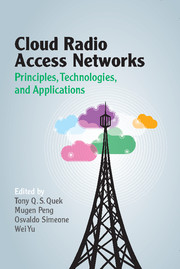Book contents
- Frontmatter
- Contents
- Acknowledgments
- Foreword
- Preface
- List of Contributors
- Part I Architecture of C-RANs
- Part II Physical-Layer Design in C-RANs
- 3 The Tradeoff of Computational Complexity and Achievable Rates in C-RANs
- 4 Cooperative Beamforming and Resource Optimization in C-RANs
- 5 Training Design and Channel Estimation in C-RANs
- 6 Massive MIMO in C-RANs
- 7 Large-Scale Convex Optimization for C-RANs
- 8 Fronthaul Compression in C-RANs
- 9 Adaptive Compression in C-RANs
- Part III Resource Allocation and Networking in C-RANs
- Part IV Networking in C-RANs
- Index
- References
7 - Large-Scale Convex Optimization for C-RANs
from Part II - Physical-Layer Design in C-RANs
Published online by Cambridge University Press: 23 February 2017
- Frontmatter
- Contents
- Acknowledgments
- Foreword
- Preface
- List of Contributors
- Part I Architecture of C-RANs
- Part II Physical-Layer Design in C-RANs
- 3 The Tradeoff of Computational Complexity and Achievable Rates in C-RANs
- 4 Cooperative Beamforming and Resource Optimization in C-RANs
- 5 Training Design and Channel Estimation in C-RANs
- 6 Massive MIMO in C-RANs
- 7 Large-Scale Convex Optimization for C-RANs
- 8 Fronthaul Compression in C-RANs
- 9 Adaptive Compression in C-RANs
- Part III Resource Allocation and Networking in C-RANs
- Part IV Networking in C-RANs
- Index
- References
Summary
Introduction
7.1.1 C-RANs
The proliferation of “smart” mobile devices, coupled with new types of wireless applications, has led to an exponential growth in wireless and mobile data traffic. In order to provide high-volume and diversified data services, C-RAN [1, 2] has been proposed; it enables efficient interference management and resource allocation by shifting all the baseband units (BBUs) to a single cloud data center, i.e., by forming a BBU pool with powerful shared computing resources. Therefore, with efficient hardware utilization at the BBU pool, a substantial reduction can be obtained in both the CAPEX (e.g., via low-cost site construction) and the OPEX (e.g., via centralized cooling). Furthermore, the powerful conventional base stations are replaced by light and low-cost remote radio heads (RRHs), with the basic functionalities of signal transmission and reception, which are then connected to the BBU pool by high-capacity and low-latency optical fronthaul links. The capacity of C-RANs can thus be significantly improved through network densification and large-scale centralized signal processing at the BBU pool. By further pushing a substantial amount of data, storage, and computing resources (e.g., the radio access units and end-user devices) to the edge of the network, using the principle of mobile edge computing (i.e., fog computing) [3], heterogeneous C-RANs [4], as well as Fog-RANs and MENG-RANs [5] can be formed. These evolved architectures will further improve user experience by offering on-demand and personalized services and location-aware and content-aware applications. In this chapter we investigate the computation aspects of this new network paradigm, and in particular focus on the large-scale convex optimization for signal processing and resource allocation in C-RANs.
7.1.2 Large-Scale Convex Optimization: Challenges and Previous Work
Convex optimization serves as an indispensable tool for resource allocation and signal processing in wireless networks [6-9]. For instance, coordinated beamforming [10] often yields a convex optimization formulation, i.e., second-order cone programming (SOCP) [11]. The network max-min fairness-rate optimization [12] can be solved through the bisection method [11], in polynomial time; in this method a sequence of convex subproblems needs to be solved.
Information
- Type
- Chapter
- Information
- Cloud Radio Access NetworksPrinciples, Technologies, and Applications, pp. 149 - 178Publisher: Cambridge University PressPrint publication year: 2017
